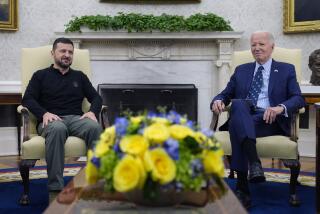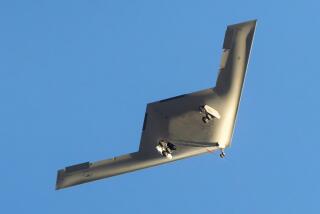Youthful Makeover for Aging Aircraft
- Share via
ABOVE THE SIERRA NEVADA — As the B-1 bomber linked up with an aerial refueling tanker at 18,000 feet, the “old girl” seemed to show her age.
Tethered precariously to the tanker by a long boom, the 20-year-old bomber suddenly rattled and shook.
But moments later, after having taken on a load of fuel, the B-1 came alive as it disconnected itself from the tanker, swept its wings back and began a supersonic dash across the Mojave Desert to make a ceremonial flight over the Los Angeles County Fair.
“There is still a lot left in this old girl,” Lt. Col. Matt Bartlett said as he first slowed the plane down for the flyover and then pushed the throttle to full, creating a burst of ear-piercing noise that set off dozens of car alarms below.
The B-1 fleet has had a $2.3-billion makeover, and more is in the works, transforming what was once a much-maligned relic of the Cold War to a workhorse of air campaigns in Afghanistan and Iraq.
It isn’t alone. With few new weapons in the pipeline and many aircraft aging beyond their warranties, the Pentagon has embarked on one of its biggest refurbishment efforts in more than two decades.
And that is translating into big bucks for defense firms -- with many of them, including B-1 program contractor Boeing Co., boasting operations and teams of suppliers in Southern California.
The amount of work being generated is “absolutely huge,” said Loren Thompson, chief operating officer for the Lexington Institute, a think tank in Arlington, Va.
In recent weeks, Boeing has found itself the target of pointed criticism from Sen. John McCain (R-Ariz.) and others for a plan to manufacture 100 commercial jetliners, convert them into aerial refueling tankers and then lease them to the Air Force for $16 billion. The Air Force would have the option of purchasing the planes for $4 billion at the expiration of the six-year lease.
Last month, the Pentagon’s internal watchdog agency launched an investigation into allegations that Boeing may have illegally obtained proprietary information from European rival Airbus to secure the deal.
Yet although the lease proposal has sparked headlines, it’s the more mundane business of fixing up old aircraft that has helped turn Boeing’s defense division into a big moneymaker.
“In the current budgetary environment,” noted Thompson, “the Pentagon may have to delay new weapons development, and that means it will have to spend a lot of money to keep the old weapons combat ready.”
For Boeing, the nation’s second-largest defense contractor, upgrading and refurbishing aircraft is now one of its fastest-growing segments of its business.
Such work generated about $4 billion in sales last year, or about 20% of the Chicago-based company’s defense-related revenue. That sum is expected to more than double in the next five years.
At Boeing’s helicopter plant in Mesa, Ariz., thousands of workers no longer make new aircraft for the Pentagon. Yet the factory floor is bustling with activity, turning old Apache attack helicopters into near-new, more lethal Apache Longbows.
In a glimpse of what the aircraft industry could become, beat-up, combat-worn AH-64 Apaches -- most of them built in the 1980s -- make their way into a building akin to an auto body shop.
Each aircraft is stripped down to the bare structure, which is then patched up, repainted and moved to a second building where much of the rebuilding takes place.
The work, which can cost $5 million to $10 million per aircraft depending on the extent of the refurbishment, includes new wiring, radar and avionics, making the aircraft four times more capable of identifying and striking a target than its predecessor, Boeing executives say.
An Apache Longbow, for instance, can now strike a target even if it is not in its visual line of sight, greatly extending its range. Building an Apache Longbow from scratch would cost about $20 million.
Such upgrades are being made to many of the Pentagon’s mainline combat aircraft, including the F-14, F-15 and F-16 fighters as well as B-1, B-2 and B-52 bombers.
No one knows for sure exactly how much the Pentagon plunks down for upgrades each year because the spending is often couched in myriad budget items, from each individual weapons project to general categories such as research and development, as well as maintenance and operation. Many of the programs are also classified and not revealed in public budget documents.
But some analysts believe that the Pentagon will spend up to a quarter of its $75-billion procurement budget to refurbish and upgrade existing aircraft, tanks and ships this fiscal year. Tens of billions more are likely to be spent on researching and developing new radars, avionics and computer systems for the aging fleet.
For instance, the Air Force Materiel Command, which oversees aircraft development and maintenance for the service, says it alone will spend $15 billion upgrading and refurbishing aircraft, rockets and missiles this year. The spending will go toward, among other things, developing new equipment, software and munitions that will be added to the existing fleet. That’s up from $10 billion three years ago.
Meanwhile the Army, which has the smallest procurement budget among the armed services, expects to spend nearly $2 billion on modernizing its aircraft fleet this year, more than double the $805 million it spent five years ago.
“The idea is to rebuild them with new, updated electronic equipment to give them extra power,” said Richard Aboulafia, a defense analyst for Teal Group. “Most of the technological progress these days is in subsystems. That’s where the money is.”
Based on the Pentagon’s current budget plans, Craig Fraser, analyst for Fitch Ratings, believes that modernization spending could grow at an annual rate of 6.2% for the next six years.
The primary beneficiaries, according to Thompson, are companies that delivered aircraft and ground vehicles 10 or 20 years ago “because those are the systems that are going to require upgrades to be combat-ready.”
The trend is helping many local aerospace subcontractors offset a sharp drop-off in business for commercial aircraft parts. Long Beach-based Ducommun Inc., for instance, says that about 20% of the revenue from its technology unit now comes from making upgrades for radars and avionics systems that go into F-15s and F-18s. Ducommun’s technology business, most of which is defense-related, posted $77 million in sales last year.
“It’s been gradually growing,” Ducommun Chief Executive Joseph C. Berenato said. “Upgrades are now a big deal in defense spending.”
Even the B-2 stealth bomber, one of the more modern aircraft in the U.S. military inventory, having left the factory in the early 1990s, is undergoing modifications. Northrop Grumman Corp., which has 1,200 workers on the B-2 program, many of them in Palmdale and El Segundo, recently received a $1.2-billion contract to upgrade the B-2’s radar.
Last month, in a showcase of its new capabilities, a modified B-2 dropped 80 satellite-guided bombs on 80 separate targets simultaneously. According to the Air Force, all 80 hit their marks, the first time in history that so many bombs hit so many targets in a single drop.
Upgrades aren’t confined to aircraft. Tanks, missiles and even bombs are getting spiffed up. The Air Force, for instance, plans to spend more than $2.4 billion over the next three years fitting simple gravity bombs with global positioning kits, making them highly accurate. For its part, the Army will spend $1.5 billion adding stronger armor and deadlier guns to its M-1 Abrams tanks.
But one of the biggest beneficiaries of the modernization efforts has been the B-1. The plane was designed to penetrate deep into the Soviet Union by flying low to the ground and deliver nuclear bombs. Later, under a $2.3-billion contract, it was modified to carry conventional bombs. In Afghanistan and Iraq, it was credited with dropping more precision munitions than any other U.S. aircraft.
About 800 Boeing employees, most of them in Long Beach, work on the B-1 program.
Another contract that would update the bomber’s communications system is under consideration. That contract could be worth up to $1.5 billion.
The Air Force also is considering putting new engines on the B-1 to double the speed of what is already one of the fastest bombers in the world.
On Oct. 25, during an open house at Edwards Air Force Base, many of the refurbished aircraft will be on display, including the B-1 and the B-2 bombers, as well as the F-15 and F-16 jets. The newest jet in the fleet, the F/A-22 fighter, built by Lockheed Martin Corp., may also make its first public appearance.
But the B-1 could well grab much of the attention. It will attempt to break 52 world aviation records during the air show. “We’re not the [Chuck] Yeagers of the 1950s going higher and faster,” said bomber pilot Bartlett. “We’re trying to get the most out of what we have.”
More to Read
Inside the business of entertainment
The Wide Shot brings you news, analysis and insights on everything from streaming wars to production — and what it all means for the future.
You may occasionally receive promotional content from the Los Angeles Times.










